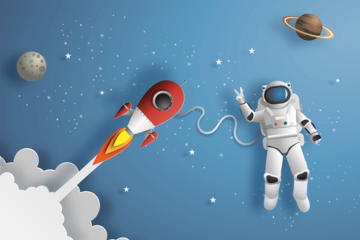Browse
Assessing Learning
Posted on: #iteachmsu

ASSESSING LEARNING
Categorization of Artificial Intelligence
Categories of AI
Artificial intelligence:
can be divided into two different categories: weak and strong. Weak artificial intelligence embodies a system designed to carry out one particular job. Weak AI systems include video games such as the chess example from above and personal assistants such as Amazon's Alexa and Apple's Siri. You ask the assistant a question, it answers it for you.
Strong artificial intelligence systems are systems that carry on the tasks considered to be human-like. These tend to be more complex and complicated systems. They are programmed to handle situations in which they may be required to problem solve without having a person intervene. These kinds of systems can be found in applications like self-driving cars or in hospital operating rooms.
Artificial intelligence:
can be divided into two different categories: weak and strong. Weak artificial intelligence embodies a system designed to carry out one particular job. Weak AI systems include video games such as the chess example from above and personal assistants such as Amazon's Alexa and Apple's Siri. You ask the assistant a question, it answers it for you.
Strong artificial intelligence systems are systems that carry on the tasks considered to be human-like. These tend to be more complex and complicated systems. They are programmed to handle situations in which they may be required to problem solve without having a person intervene. These kinds of systems can be found in applications like self-driving cars or in hospital operating rooms.
Authored by:
Rupali

Posted on: #iteachmsu


Categorization of Artificial Intelligence
Categories of AI
Artificial intelligence:
can be divided into two d...
Artificial intelligence:
can be divided into two d...
Authored by:
ASSESSING LEARNING
Monday, Jan 11, 2021
Posted on: #iteachmsu

ASSESSING LEARNING
THE TOP MYTHS ABOUT ADVANCED AI
common myths
for Advanced
AI:A captivating conversation is taking place about the future of artificial intelligence and what it will/should mean for humanity. There are fascinating controversies where the world’s leading experts disagree, such as AI’s future impact on the job market; if/when human-level AI will be developed; whether this will lead to an intelligence explosion; and whether this is something we should welcome or fear. But there are also many examples of boring pseudo-controversies caused by people misunderstanding and talking past each other.
TIMELINE MYTHS
The first myth regards the timeline: how long will it take until machines greatly supersede human-level intelligence? A common misconception is that we know the answer with great certainty.
One popular myth is that we know we’ll get superhuman AI this century. In fact, history is full of technological over-hyping. Where are those fusion power plants and flying cars we were promised we’d have by now? AI has also been repeatedly over-hyped in the past, even by some of the founders of the field. For example, John McCarthy (who coined the term “artificial intelligence”), Marvin Minsky, Nathaniel Rochester, and Claude Shannon wrote this overly optimistic forecast about what could be accomplished during two months with stone-age computers: “We propose that a 2 month, 10 man study of artificial intelligence be carried out during the summer of 1956 at Dartmouth College […] An attempt will be made to find how to make machines use language, form abstractions, and concepts, solve kinds of problems now reserved for humans, and improve themselves. We think that a significant advance can be made in one or more of these problems if a carefully selected group of scientists work on it together for a summer.”
CONTROVERSY MYTHS
Another common misconception is that the only people harboring concerns about AI and advocating AI safety research are Luddites who don’t know much about AI. When Stuart Russell, author of the standard AI textbook, mentioned this during his Puerto Rico talk, the audience laughed loudly. A related misconception is that supporting AI safety research is hugely controversial. In fact, to support a modest investment in AI safety research, people don’t need to be convinced that risks are high, merely non-negligible — just as a modest investment in home insurance is justified by a non-negligible probability of the home burning down.
for Advanced
AI:A captivating conversation is taking place about the future of artificial intelligence and what it will/should mean for humanity. There are fascinating controversies where the world’s leading experts disagree, such as AI’s future impact on the job market; if/when human-level AI will be developed; whether this will lead to an intelligence explosion; and whether this is something we should welcome or fear. But there are also many examples of boring pseudo-controversies caused by people misunderstanding and talking past each other.
TIMELINE MYTHS
The first myth regards the timeline: how long will it take until machines greatly supersede human-level intelligence? A common misconception is that we know the answer with great certainty.
One popular myth is that we know we’ll get superhuman AI this century. In fact, history is full of technological over-hyping. Where are those fusion power plants and flying cars we were promised we’d have by now? AI has also been repeatedly over-hyped in the past, even by some of the founders of the field. For example, John McCarthy (who coined the term “artificial intelligence”), Marvin Minsky, Nathaniel Rochester, and Claude Shannon wrote this overly optimistic forecast about what could be accomplished during two months with stone-age computers: “We propose that a 2 month, 10 man study of artificial intelligence be carried out during the summer of 1956 at Dartmouth College […] An attempt will be made to find how to make machines use language, form abstractions, and concepts, solve kinds of problems now reserved for humans, and improve themselves. We think that a significant advance can be made in one or more of these problems if a carefully selected group of scientists work on it together for a summer.”
CONTROVERSY MYTHS
Another common misconception is that the only people harboring concerns about AI and advocating AI safety research are Luddites who don’t know much about AI. When Stuart Russell, author of the standard AI textbook, mentioned this during his Puerto Rico talk, the audience laughed loudly. A related misconception is that supporting AI safety research is hugely controversial. In fact, to support a modest investment in AI safety research, people don’t need to be convinced that risks are high, merely non-negligible — just as a modest investment in home insurance is justified by a non-negligible probability of the home burning down.
Authored by:
Rupali

Posted on: #iteachmsu


THE TOP MYTHS ABOUT ADVANCED AI
common myths
for Advanced
AI:A captivating conversation is taking p...
for Advanced
AI:A captivating conversation is taking p...
Authored by:
ASSESSING LEARNING
Monday, Jan 11, 2021
Posted on: #iteachmsu

Assessing Learning
EXAMPLES OF ARTIFICIAL INTELLIGENCE IN USE TODAY
Posted by:
Rupali Jagtap

Posted on: #iteachmsu


Posted by
over 4 years ago
The concept that computer programs can automatically learn from and adapt to new data without being assisted by humans. Deep learning techniques enable this automatic learning through the absorption of huge amounts of unstructured data such as text, images, or video.
Posted on: #iteachmsu


Posted by
over 4 years ago
Artificial Intelligence (AI) is the branch of computer sciences that emphasizes the development of intelligent machines, thinking and working like humans. For example, speech recognition, problem-solving, learning, and planning.
Assessing Learning
Posted on: #iteachmsu



Posted by
over 4 years ago

It’s easy to think nature will always be with us.
it depends on whether we let nature go to the wall or act to repair, restore, and maintain it. Right now species are going extinct and the natural systems that support all life on Earth are being eroded faster than ever before.
Even once common species like bees, hedgehogs, starlings and house sparrows are in trouble – going missing from our streets and neighbourhoods. The bees and birds lose out big time – and so do we.
it depends on whether we let nature go to the wall or act to repair, restore, and maintain it. Right now species are going extinct and the natural systems that support all life on Earth are being eroded faster than ever before.
Even once common species like bees, hedgehogs, starlings and house sparrows are in trouble – going missing from our streets and neighbourhoods. The bees and birds lose out big time – and so do we.
Assessing Learning
Posted on: #iteachmsu


Posted by
over 4 years ago
The robot misconception is related to the myth that machines can’t control humans.
Intelligence enables control: humans control tigers not because we are stronger, but because we are smarter. This means that if we cede our position as smartest on our planet, it’s possible that we might also cede control.
Intelligence enables control: humans control tigers not because we are stronger, but because we are smarter. This means that if we cede our position as smartest on our planet, it’s possible that we might also cede control.
Posted on: #iteachmsu

Assessing Learning
BENEFITS & RISKS OF ARTIFICIAL INTELLIGENCE
Posted by:
Rupali Jagtap


